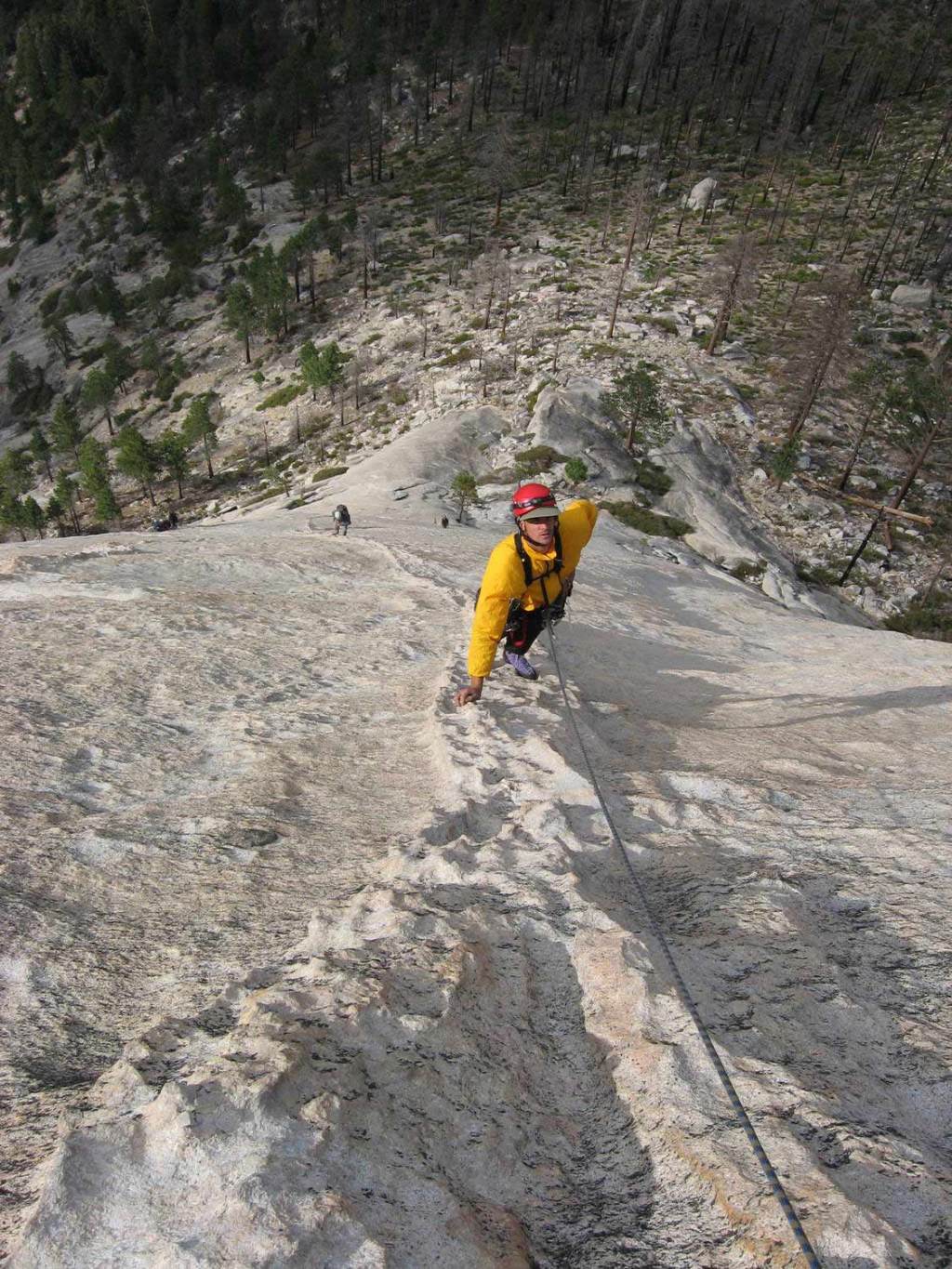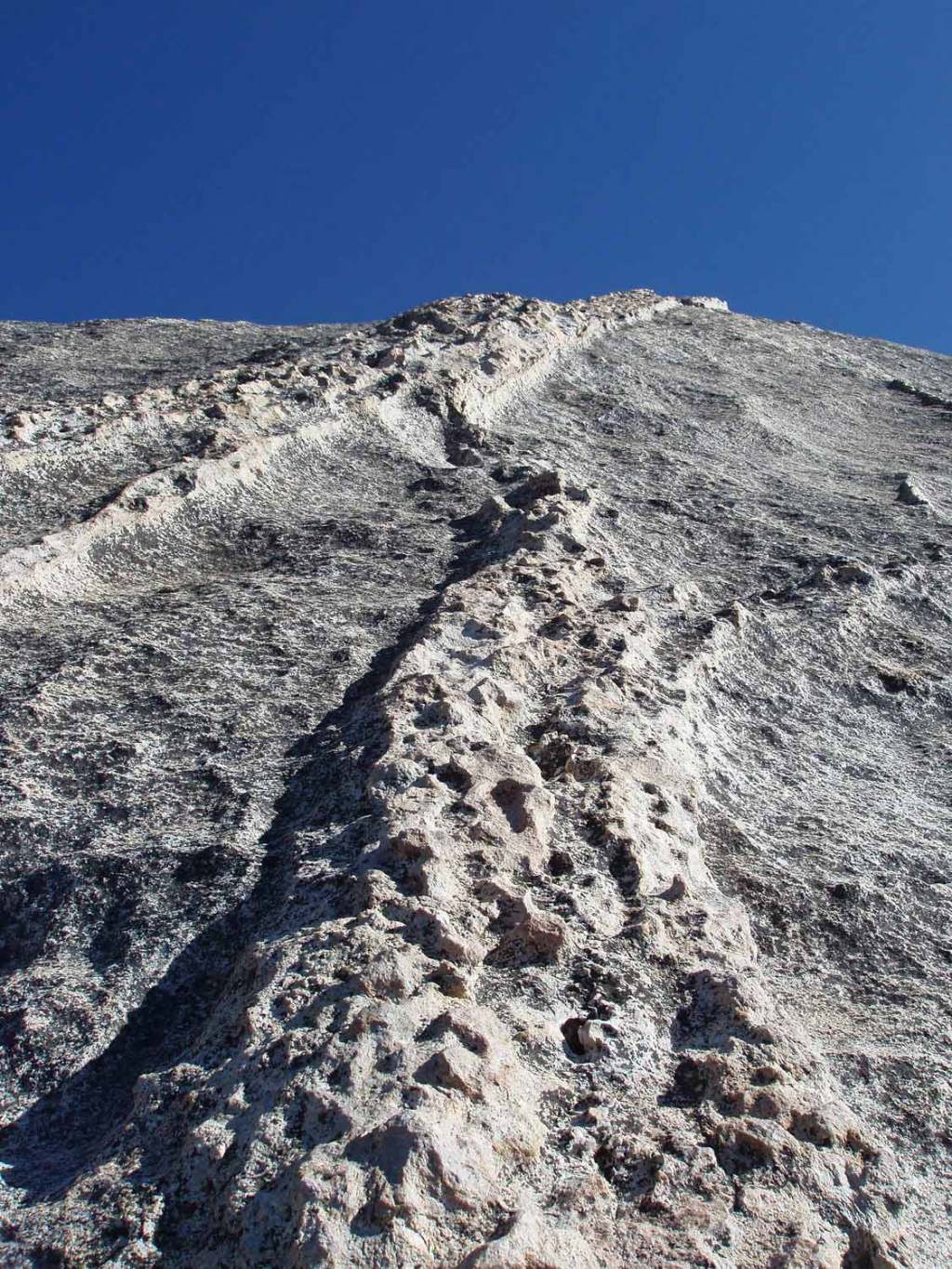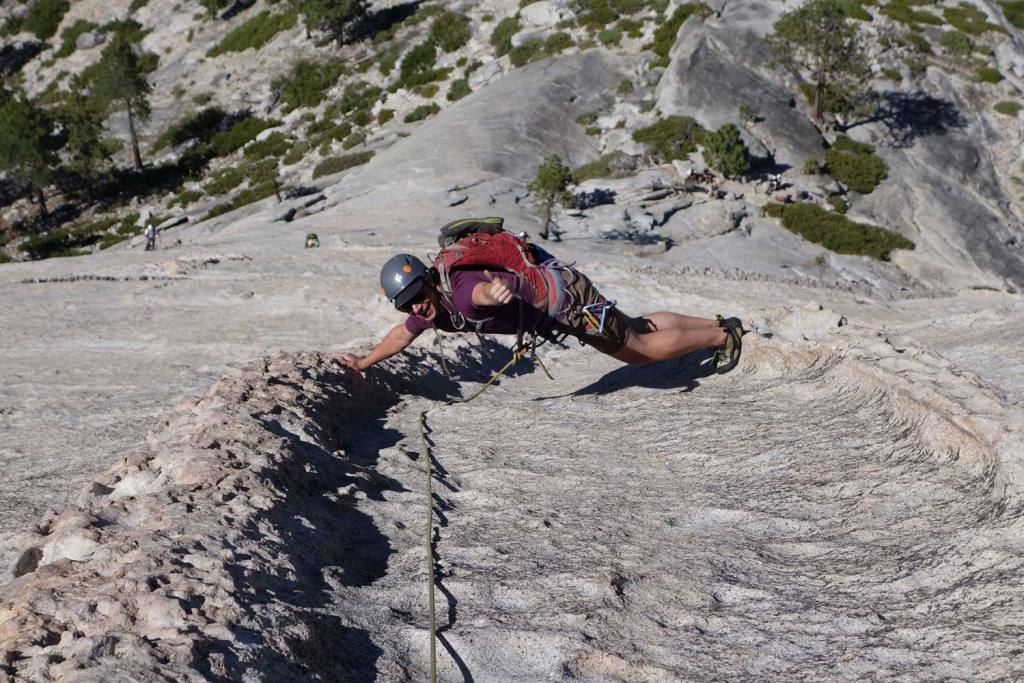The Snake Dike was a Stone Masters’ consolation prize
Mighty Half Dome practically embodies an American icon of impregnability.
Before Snake Dike, an 8-pitch 5.7 that sees hundreds of attempts annually, who could have imagined that this great, sheer stone held a route so remarkably clean and moderate that it would gain the reputation as a must-do warmup for first-time Yosemite climbers?
For parties able to negotiate runouts and traffic, the flawless crystal-path running for hundreds of feet in such a lofty position indeed makes the Snake Dike anomaly an experience not to be missed. What’s really funny, though, is how this classic was discovered by happenstance, an unplanned consolation when three Valley hardmen went up to climb a very different route.

The low angle and featured texture make the long runouts relatively comfortable for experienced climbers. | Photo submitted by MP user Lee Jensen
The organizer of this summer of ‘65 escapade was a Berkeley math major named Eric Beck. Among the ruffians, carousers, dissidents, and maestros manufacturing the Golden Age of Yosemite climbing, Beck was a wry bohemian and brazen dirt-bagger. He was one of the first artful scarfers at the Lodge cafeteria, and he’d famously be quoted, “At either end of the social spectrum there lies a leisure class.” Beck was efficient in every way, with a lot of avant-garde mileage on edgy face routes on Middle Cathedral, and some Tuolumne time too.
Beck saw a likely crack route running right along the southwest edge of Half Dome. To try this project, he recruited two younger climbers, Chris Fredericks and Jim Bridwell. Bridwell, 21 at the time, had crashed into the Valley a couple of Aprils before as the alpha among a troupe of San Jose kids. They’d announced they intended to ascend the northeast buttress of Higher Cathedral, even though it was still draped in icicles. They’d made it up several pitches, and regulars like Beck were impressed. Within a few years, Bridwell of course would don the mantle of king of the new Valley generation.
The trio arrived at the edge of Half Dome, but their excitement deflated as they looked up at a horrendously flaring and overhanging crack. (It would take Dale Bard’s mastery to climb this 10 years later, at 5.11b). They agreed to turn tail, but on their way back beneath the generally blank southwest face, they started perusing the dikes that run like veins up the wall. Two dikes in particular stood out: one ran straight up like a drawn trajectory, and to its left ran a more wiggly mate that they dubbed “the snake dike.” The direct dike especially beckoned; should they have a look? As on a Tuolumne dome, climbing would have to be bolt protected, but they had just a dozen or less 1/4-inch Rawl Drives they’d scrounged from various comrades. Daylight was also too far along to think of climbing such a big face that day, but they decided they could explore up a couple of pitches and leave the ropes hanging for a return.
They wrapped on their swami belts, snugged down their lug-soled climbing shoes, put on a hip belay, and Beck started up.
He worked left around a small roof with a tree and continued to a nice ledge. Fredericks then led up a corner and worked left to drill in a belay not far from the start of the dikes. Then Bridwell ventured 15 feet up onto the direct dike and put in a protection bolt. Above there the prospects seemed too meager. Fredericks, and then Beck also, went up and found the same (this dike would eventually go at 5.9-5.10 in 1985, as Eye in The Sky). They decided to shift to the “snake dike,” and to their delight, Beck found that this dike featured so many crystal-knobs, scoops, edges, chicken-heads, and rugosities that it was practically a ladder of reasonable—even easy—climbing. He ran out the whole rope before putting in a bolt, and announced that the well-featured dike kept going.

Pitch 6 | Photo submitted by MP user Mark Roth
They’d found a classic granitic feature that had formed deep in the earth under great pressure and heat millions of years ago, when a molten distillation of denser minerals was squeezed into a split in the already-solid granite. Such injections cool quickly into fine-grained dikes that resist weathering and come to stand out from the surrounding stone. The trio decided to run with the opportunity.
To keep a modicum of safety yet conserve bolts and time for the undoubtedly great spans above, Beck belayed up Fredericks on his one bolt, while Bridwell stayed back at the bolt below. Fredericks extended the lead, again running the whole rope before stopping to drill another bolt. As he stood on edges and hammered away, the drill broke. Expletives rained down, but Fredericks extracted the fractured tip, finished the hole with the broken stem, and with great relief pounded home a Rawl. Sequentially then, they belayed Bridwell up so he could take the next lead up the incredible meter-wide crystal road that ran up the sea of blank stone. Bridwell also stretched the rope to its end before drilling in a single bolt.
Back then, bolts were thought to be fairly bomber and more faith was put into simply not falling anyway. Today though, all three of these guys know it was foolish to put such trust in those few little studs and hangers. Not far above the angle kicked back, and they were able to scamper up and over the summit. They returned to Camp 4 where their shit-eating grins and reasonably early return did not persuade anyone they’d put up a new route on the great Half Dome.
When they insisted,“swear to God, it’s only 5.7,” the Camp 4 consensus was “No. Way.”
A couple of days later Beck’s mentor and friend Steve Roper, the Valley guidebook author, marched up there. Beck implored him to add bolts, at the belays for sure, and some for protection too. Roper did so with an emphasis on some and came back with the verifying story. A few days after that, Tom Kimbrough made the third ascent and certified the dike as an unlikely and amazing line, mostly 5.5 and easier. Almost overnight, Snake Dike became everyone’s fun-jaunt up Half Dome, and the previously popular Salathé Route (Southwest Face) to the left fell into obscurity.
Today, the old 1/4-inchers have been replaced with stout 3/8-inch stainless bolts. But the spacing as defined by Roper’s ascent remains scanty and serious, and there have been fatalities. Beck himself argues that more protection bolts should be added, but Snake Dike remains a Tuolumne-like challenge for runout-ready climbers on fair-weather days.

Photo submitted by MP user Brian Shedden
Claude Fiddler, a Camp 4-Tuolumne regular through the ‘80s, calls Snake Dike, “a classic. I’ll never forget going up there with a whole posse of Valley regulars, carrying full bivouac and party regalia. We set up and watched the full moon rise and turn blood red with an eclipse. That was a religious experience.”
